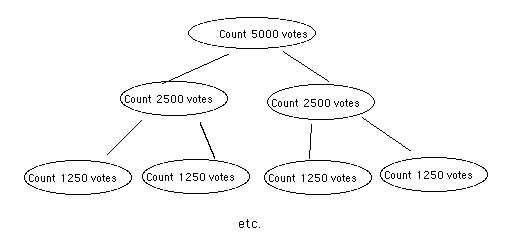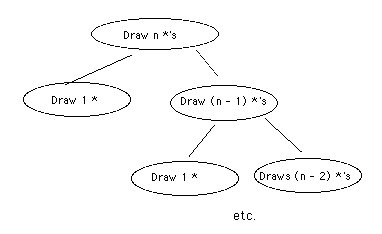
CSCI 150, Spring 2003
Home | | Course Schedule | | Assignments | | Lecture Notes
1. Recursion is a special case of Divide and Conquer problem solving
One powerful technique for solving big problems is to divide the big problem into smaller
problems, each of which is easier to solve. Recursion can be used to solve problems in which
these smaller subproblems are smaller versions of the original problem.

2. Writing Recursive Procedures:
Example: Write a procedure to draw n stars, where n is an integer parameter.
Strategy:
1) Draw 1 star 2) Draw (n - 1) stars
Picture:

Pascal Code:
program drawing;
procedure drawStars( n : integer );
begin
if n < = 0 then {Stopping condition or base case}
begin
{do nothing}
end
else {General case }
begin
write( '*' );
drawStars( n - 1 );
end;
end;
begin
drawStars(3);
end.
3. Rules for Recursive procedures (or functions).
4. Classic examples of Recursion: Factorial
n! = n * (n-1)!
Factorial(n) = n * Factorial (n - 1 ) for n > 0
Factorial(0) = 1
Pascal Code:
function factorial( n: integer): integer;
begin
if n <= 0 then
begin
factorial := 1; {return the value of 1}
end
else
begin
factorial := n * factorial( n-1 ); {return n*(n-1)! }
end;
end;
5. Classic examples of Recursion: Fibonacci
Fibonacci sequence: 1 1 2 3 5 8 13 ...
Pascal Code:
function fib( n: integer): integer;
begin
if n <= 1 then
begin
fib := n; {return the value of 0 or 1}
end
else
begin
fib := fib(n-1) + fib(n-2);
end;
end;